Approaches to the Functionalization of Organosilicon Dendrones Based on Limonene
Abstract
1. Introduction
2. Experimental
2.1. Material and Methods
2.2. Material and Methods
- Diallyl(2-(4-methylcyclohex-3-en-1-yl)propyl)methylsilane (Lim-G0All2)
- Triallyl(2-(4-methylcyclohex-3-en-1-yl)propyl)silane (Lim-G0All3)
- Dendrimer of the first generation (Lim-G1All4)
- 1,1,1,3,5,5,5-heptamethyl-3-(2-(4-methylcyclohex-3-en-1-yl)propyl)trisiloxane (Lim-G0.5TMS2)
- Bis(heptamethylsilylpropyl)methylsilyllimonene (Lim-G1.5TMS4)
- Tris(heptamethylsilylpropyl)silyllimonene (Lim-G1.5TMS6)
- Dendrimer of the 2.5 generation (Lim-G2.5TMS8)
- CD of the first generation (Lim-G1Cl4)
- CD of the first generation (Lim-G1Bu4)
- 3-Chloropropyldimethylsilane
- Bis(3-chloropropyldimethylsilylpropyl)methylsilyllimonene (Lim-G0(PrCl)2)
- Tris(3-chloropropyldimethylsilylpropyl)silyllimonene (Lim-G1(PrCl)3)
- Dendrimer of the 2.5 generation (Lim-G2(PrCl)4)
- Bis(3-azidopropyldimethylsilylpropyl)methylsilyllimonene (Lim-G0(PrN3)2)
- Tris(3-azidopropyldimethylsilylpropyl)silyllimonene (Lim-G1(PrN3)3)
- CD of the 2.5 generation (Lim-G2(PrN3)4)
- 1,1,1,3,5,5,5-Heptamethyl-3-(2-(3,4-epoxy-4-methylcyclohex-1-yl)propyl)trisiloxane (LimOx-G0.5TMS2)
- Bis(heptamethylsilylpropyl)methylsilyl-1,2-epoxy-limonene (LimOx-G1.5TMS4)
- Tris(heptamethylsilylpropyl)silyl-1,2-epoxy-limonene (LimOx-G1.5TMS6)
- Epoxidized dendrimer of the 2.5 generation (LimOx-G2.5TMS8)
- Epoxidized dendrimer of the first generation (LimOx-G1Bu4)
- Azide-functionalized dendrimer of the first generation (LimN3-G1Bu4)
- Hydroxy-functionalized dendrimer of the first generation (LimOH-G1Bu4)
- Propargylate-functionalized dendrimer of the first generation (LimC≡C-G1Bu4)
3. Results and Discussion
3.1. Epoxidation of Limonene-Based Carbosilane and Carbosilane-Siloxane Dendrons
3.2. Opening of the Oxirane Ring in Limonene-Based Carbosilane and Carbosilane-Siloxane Dendrons
3.3. Functionalization of the Periphery of Limonene-Based Carbosilane Dendrons
4. Conclusions
Supplementary Materials
Author Contributions
Funding
Institutional Review Board Statement
Informed Consent Statement
Data Availability Statement
Conflicts of Interest
References
- Kaur, D.; Jain, K.; Mehra, N.K.; Kesharwani, P.; Jain, N.K. A review on comparative study of PPI and PAMAM dendrimers. J. Nanopart. Res. 2016, 18, 146. [Google Scholar] [CrossRef]
- Esfand, R.; Tomalia, D.A. Poly(amidoamine) (PAMAM) dendrimers: From biomimicry to drug delivery and biomedical applications. Drug Discov. Today 2001, 6, 427–436. [Google Scholar] [CrossRef]
- Astruc, D.; Chardac, F. Dendritic Catalysts and Dendrimers in Catalysis. Chem. Rev. 2001, 101, 2991–3024. [Google Scholar] [CrossRef] [PubMed]
- Roesler, R.; Har, B.J.N.; Piers, W.E. Synthesis and Characterization of (Perfluoroaryl)borane-Functionalized Carbosilane Dendrimers and Their Use as Lewis Acid Catalysts for the Hydrosilation of Acetophenone. Organometallics 2002, 21, 4300–4302. [Google Scholar] [CrossRef]
- Nager, M.; Becke, S.; Windisch, H.; Denninger, U. Noncoordinating Dendrimer Polyanions: Cocatalysts for the Metallocene-Catalyzed Olefin Polymerization. Angew. Chem. Int. Ed. 2001, 40, 1898–1902. [Google Scholar]
- Yamamoto, K.; Imaoka, T. Precision Synthesis of Subnanoparticles Using Dendrimers as a Superatom Synthesizer. Acc. Chem. Res. 2014, 47, 1127–1136. [Google Scholar] [CrossRef]
- Yamamoto, K.; Takanashi, K. Synthesis and functionality of dendrimer with finely controlled metal assembly. Polymer 2008, 49, 4033–4041. [Google Scholar] [CrossRef]
- Imaoka, T.; Kawana, Y.; Kurokawa, T.; Yamamoto, K. Macromolecular semi-rigid nanocavities for cooperative recognition of specific large molecular shapes. Nat. Commun. 2013, 4, 2581. [Google Scholar] [CrossRef] [PubMed]
- Yokoyama, S.; Otomo, A.; Nakahama, T.; Okuno, Y.; Mashiko, S. Dendrimers for optoelectronic applications. In Dendrimers V: Functional and Hyperbranched Building Blocks, Photophysical Properties, Applications in Materials and Life Sciences; Springer: Berlin/Heidelberg, Germany, 2003; Volume 228, p. 205. [Google Scholar]
- Cho, M.J.; Choi, D.H.; Sullivan, P.A.; Akelaitis, A.J.P.; Dalton, L.R. Recent progress in second-order nonlinear optical polymers and dendrimers. Prog. Polym. Sci. 2008, 33, 1013–1058. [Google Scholar] [CrossRef]
- Sullivan, P.A.; Aklelaitis, A.J.P.; Lee, S.K.; Mcgrew, G.; Lee, S.K.; Choi, D.H.; Dalton, L.R. Novel dendritic chromophores for electro-optics: Influence of binding mode and attachment flexibility on electro-optic behavior. Chem. Mater. 2006, 18, 344–351. [Google Scholar] [CrossRef]
- Sullivan, P.A.; Olbricht, B.C.; Akelaitis, A.J.P.; Mistry, A.A.; Liao, Y.; Dalton, L.R. Tri-component Diels–Alder polymerized dendrimer glass exhibiting large, thermally stable, electro-optic activity. J. Mater. Chem. 2007, 17, 2899–2903. [Google Scholar] [CrossRef]
- Albert, I.D.L.; Marks, T.J.; Ratner, M.A. Large molecular hyperpolarizabilities. Quantitative analysis of aromaticity and auxiliary donor–acceptor effects. J. Am. Chem. Soc. 1997, 119, 6575–6582. [Google Scholar] [CrossRef]
- Min, J.; Luponosov, Y.N.; Zhang, Z.-G.; Ponomarenko, S.A.; Ameri, T.; Li, Y.-F.; Brabec, C.J. Interface Design to Improve the Performance and Stability of Solution-Processed Small-Molecule Conventional Solar Cells. Adv. Energy Mater. 2014, 4, 1400816. [Google Scholar] [CrossRef]
- Min, J.; Luponosov, Y.N.; Baran, D.; Chvalun, S.N.; Shcherbina, M.A.; Bakirov, A.V.; Dmitryakov, P.V.; Peregudova, S.M.; Kausch-Busies, N.; Ponomarenko, S.A.; et al. Effects of oligothiophene π-bridge length on physical and photovoltaic properties of star-shaped molecules for bulk heterojunction solar cells. J. Mater. Chem. A 2014, 2, 16135–16147. [Google Scholar] [CrossRef]
- Luponosov, Y.; Min, J.; Solodukhin, A.N.; Bakirov, A.V.; Dmitryakov, P.V.; Shcherbina, M.A.; Peregudova, S.M.; Cherkaev, G.V.; Chvalun, S.N.; Brabec, C.J.; et al. Star-shaped D–π–A oligothiophenes with a tris(2-methoxyphenyl)amine core and alkyldicyanovinyl groups: Synthesis and physical and photovoltaic properties. J. Mater. Chem. C 2016, 4, 7061. [Google Scholar] [CrossRef]
- Li, Y.; Yang, J.; Huang, C.; Wang, L.; Wang, J.; Chen, J. Dendrimer-functionalized mesoporous silica as a reversed-phase/anion-exchange mixed-mode sorbent for solid phase extraction of acid drugs in human urine. J. Chromatogr. A 2015, 1392, 28–36. [Google Scholar] [CrossRef]
- Gerasimov, A.V.; Ziganshin, M.A.; Vandyukov, A.E.; Kovalenko, V.I.; Gorbatchuk, V.V.; Caminade, A.-M.; Majoral, J.-P. Specific vapor sorption properties of phosphorus-containing dendrimers. J. Colloid Interface Sci. 2011, 360, 204–210. [Google Scholar] [CrossRef] [PubMed]
- Barnes, T.J.; Ametov, I.; Prestidge, C.A. Dendrimer adsorption on charged particulate surfaces. Asia-Pac. J. Chem. Eng. 2008, 3, 13–17. [Google Scholar]
- Kango, S.; Kalia, S.; Celli, A.; Njuguna, J.; Habibi, Y.; Kumar, R. Surface modification of inorganic nanoparticles for development of organic–inorganic nanocomposites—A review. Prog. Polym. Sci. 2013, 38, 1232–1261. [Google Scholar] [CrossRef]
- Shen, J.; Li, Z.; Wu, Y.; Zhang, B.; Li, F. Dendrimer-based preparation of mesoporous alumina nanofibers by electrospinning and their application in dye adsorption. Chem. Eng. J. 2015, 264, 48–55. [Google Scholar] [CrossRef]
- Acosta, E.J.; Carr, C.S.; Simanek, E.E.; Shan, D.F. Engineering Nanospaces: Iterative Synthesis of Melamine-Based Dendrimers on Amine-Functionalized SBA-15 Leading to Complex Hybrids with Controllable Chemistry and Porosity. Adv. Mater. 2004, 16, 985–989. [Google Scholar] [CrossRef]
- Du, X.; Qiao, S.Z. Dendritic Silica Particles with Center-Radial Pore Channels: Promising Platforms for Catalysis and Biomedical Applications. Small 2015, 11, 392–413. [Google Scholar] [CrossRef] [PubMed]
- Van der Made, A.W.; van Leeuwen, P.W. Silane dendrimers. J. Chem. Soc. Chem. Commun. 1992, 1400–1401. [Google Scholar] [CrossRef]
- Zhou, L.L.; Hadjichristidis, N.; Toporowski, P.M.; Roovers, J. Synthesis and Properties of Regular Star Polybutadienes with 32 Arms. J. Rubber Chem. Technol. 1992, 65, 303–314. [Google Scholar] [CrossRef]
- Martínez-Olid, F.; Benito, J.M.; Flores, J.C.; de Jesús, E. Polymetallic Carbosilane Dendrimers Containing N,N’-Iminopyridine Chelating Ligands: Applications in Catalysis. Isr. J. Chem. 2009, 49, 99–108. [Google Scholar] [CrossRef]
- Eggeling, E.B.; Hovestad, N.J.; Jastrzebski, J.T.; Vogt, G.; van Koten, G. Phosphino carboxylic acid ester functionalized carbosilane dendrimers: Nanoscale ligands for the Pd-catalyzed hydrovinylation reaction in a membrane reactor. J. Org. Chem. 2000, 65, 8857–8865. [Google Scholar] [CrossRef]
- Rodríguez, L.-I.; Rossell, O.; Seco, M.; Grabulosa, A.; Muller, G.; Rocamora, M. Carbosilane Dendrimers Peripherally Functionalized with P-Stereogenic Monophosphines. Catalytic Behavior of Their Allylpalladium Complexes in the Asymmetric Hydrovinylation of Styrene. Organometallics 2006, 25, 1368–1376. [Google Scholar] [CrossRef]
- Andrés, R.; De Jesús, E.; Fierro, J.L.G.; Terreros, P. Bifunctional carbosilane dendrons for the immobilization of zirconocene catalysts on silica. New J. Chem. 2011, 35, 2203–2211. [Google Scholar] [CrossRef]
- Gutierrez-Ulloa, C.E.; Buyanova, M.Y.; Apartsin, E.K.; Venyaminova, A.G.; Javier de la Mata, F.; Valiente, M.; Gómez, R. Amphiphilic carbosilane dendrons as a novel synthetic platform toward micelle formation. Org. Biomol. Chem. 2017, 15, 7352–7364. [Google Scholar] [CrossRef]
- Heredero-Bermejo, I.; Hernández-Ros, J.M.; Sánchez-García, L.; Maly, M.; Verdú-Expósito, C.; Soliveri, J.; Javier de la Mata, F.; Copa-Patiño, J.L.; Pérez-Serrano, J.; Sánchez-Nieves, J.; et al. Ammonium and guanidine carbosilane dendrimers and dendrons as microbicides. Eur. Polym. J. 2018, 101, 159–168. [Google Scholar] [CrossRef]
- Barrios-Gumiel, A.; Sanchez-Nieves, J.; Pérez-Serrano, J.; Gómez, R.; de la Mata, F.J. PEGylated AgNP covered with cationic carbosilane dendrons to enhance antibacterial and inhibition of biofilm properties. Int. J. Pharm. 2019, 569, 118591. [Google Scholar] [CrossRef] [PubMed]
- Guerrero-Beltrán, C.; Ceña-Diez, R.; Sepúlveda-Crespo, D.; De la Mata, J.; Gómez, R.; Leal, M.; Muñoz-Fernández, M.A.; Jiménez, J.L. Carbosilane dendrons with fatty acids at the core as a new potential microbicide against HSV-2/HIV-1 co-infection. Nanoscale 2017, 9, 17263–17273. [Google Scholar] [CrossRef] [PubMed]
- Rabiee, N.; Ahmadvand, S.; Ahmadi, S.; Fatahi, Y.; Dinarvandeh, R.; Bagherzadeh, M.; Rabiee, M.; Tahriri, M.; Tayebi, L.; Hamblini, M.R. Carbosilane dendrimers: Drug and gene delivery applications. J. Drug Deliv. Sci. Tech. 2020, 59, 101879. [Google Scholar] [CrossRef]
- Muzafarov, A.M.; Rebrov, E.A. Current trends in the chemistry of dendrimers. Polym. Sci. 2000, 42, 55–77. [Google Scholar]
- Muzafarov, A.M.; Gorbatsevich, O.B.; Rebrov, E.A.; Ignat’eva, G.M.; Chenskaya, T.B.; Myakushev, V.D.; Bulkin, A.F.; Papkov, V.S. Organosilicon dendrimers: Volume-growing polyallylcarbosilanes. Polym. Sci. 1993, 35, 1575–1580. [Google Scholar]
- Rebrov, E.A.; Leshchiner, I.D.; Muzafarov, A.M. Synthesis of Carbosilane Dendrimers with Variable Distance between Branching Nodes. Macromolecules 2012, 45, 8796–8804. [Google Scholar] [CrossRef]
- Lorenz, K.; Hölter, D.; Stühn, B.; Müllwupt, R.; Frey, H. A mesogen-functionalized carbosilane dendrimer: A dendritic liquid crystalline polymer. Adv. Mater. 1996, 8, 414–416. [Google Scholar] [CrossRef]
- Lorenz, K.; Mülhaupt, R.; Frey, H.; Rapp, U.; Mayer-Posner, F.J. Carbosilane-Based Dendritic Polyols. Macromolecules 1995, 28, 6657–6661. [Google Scholar] [CrossRef]
- Kim, C.; Hong, J.H. Carbosilane and Carbosiloxane Dendrimers. Molecules 2009, 14, 3719–3730. [Google Scholar] [CrossRef]
- Dvornic, P.R.; Owen, M.J. Silicon-Containing Dendritic Polymers; Springer: Cham, Switzerland, 2009. [Google Scholar]
- Drozdov, F.V.; Cherkaev, G.V.; Muzafarov, A.M. Synthesis of new functional siloxane derivatives of limonene. Part I: Combination of hydrosilylation and hydrothiolation reactions. J. Organomet. Chem. 2019, 880, 293–299. [Google Scholar] [CrossRef]
- Drozdov, F.V.; Tarasenkov, A.N.; Cherkaev, G.V.; Demchenko, N.V.; Buzin, M.I.; Leites, L.A.; Muzafarov, A.M. Synthesis and properties of prepolymers and their siloxane analogues by thiol-ene polyaddition of limonene with dithiols. Polym. Int. 2019, 68, 2017–2023. [Google Scholar] [CrossRef]
- Ryzhkov, A.I.; Drozdov, F.V.; Cherkaev, G.V.; Muzafarov, A.M. Synthesis of Carbosilane and Carbosilane-Siloxane Dendrons Based on Limonene. Polymers 2022, 14, 3279. [Google Scholar] [CrossRef] [PubMed]
- Kim, S.B.; Lee, C.H.; Jun, C.H. Styrylsilane coupling reagents for immobilization of organic functional groups on silica and glass surfaces. Chem. Commun. 2018, 54, 9961–9964. [Google Scholar] [CrossRef]
- Wilbon, P.A.; Chu, F.; Tang, C. Progress in Renewable Polymers from Natural Terpenes, Terpenoids, and Rosin. Macromol. Rapid Commun. 2013, 34, 8–37. [Google Scholar] [CrossRef] [PubMed]
- Ciriminna, R.; Lomeli-Rodriguez, M.; Demma Carà, P.; Lopez-Sanchez, J.A.; Pagliaro, M. Limonene: A versatile chemical of the bioeconomy. Chem. Commun. 2014, 50, 15288–15296. [Google Scholar] [CrossRef] [PubMed]
- Charbonneau, L.; Foster, X.; Kaliaguine, S. Ultrasonic and Catalyst-Free Epoxidation of Limonene and Other Terpenes Using Dimethyl Dioxirane in Semibatch Conditions. ACS Sustain. Chem. Eng. 2018, 6, 12224–12231. [Google Scholar]
- Bihanic, C.; Stanovych, A.; Pelissier, F.; Grison, C. Putting Waste to Work: The Demonstrative Example of Pyrite Quarry Effluents Turned into Green Oxidative Catalysts. ACS Sustain. Chem. Eng. 2019, 7, 6223–6233. [Google Scholar] [CrossRef]
- Schutz, L.; Kazemi, F.; Mackenzie, E.; Bergeron, J.-V.; Gagnon, E.; Claverie, J.P. Trans-limonene dioxide, a promising bio-based epoxy monomer. J. Polym. Sci. 2021, 59, 321–328. [Google Scholar] [CrossRef]
- Cimarelli, C.; Fratoni, D.; Palmieri, G. Synthesis of new enantiopure trans-3,4-diaminocaranes from (+)-3-carene. Tetrahedron Asymmetry 2011, 22, 603–608. [Google Scholar] [CrossRef]
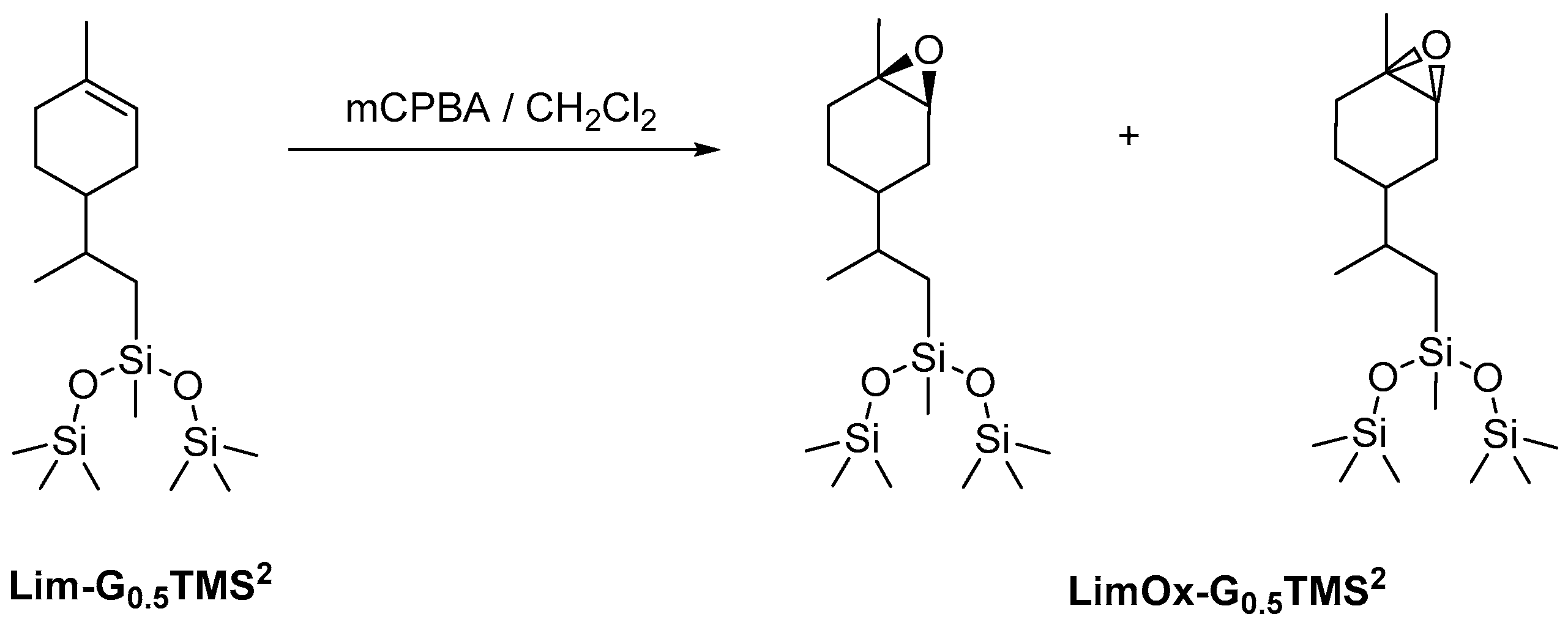
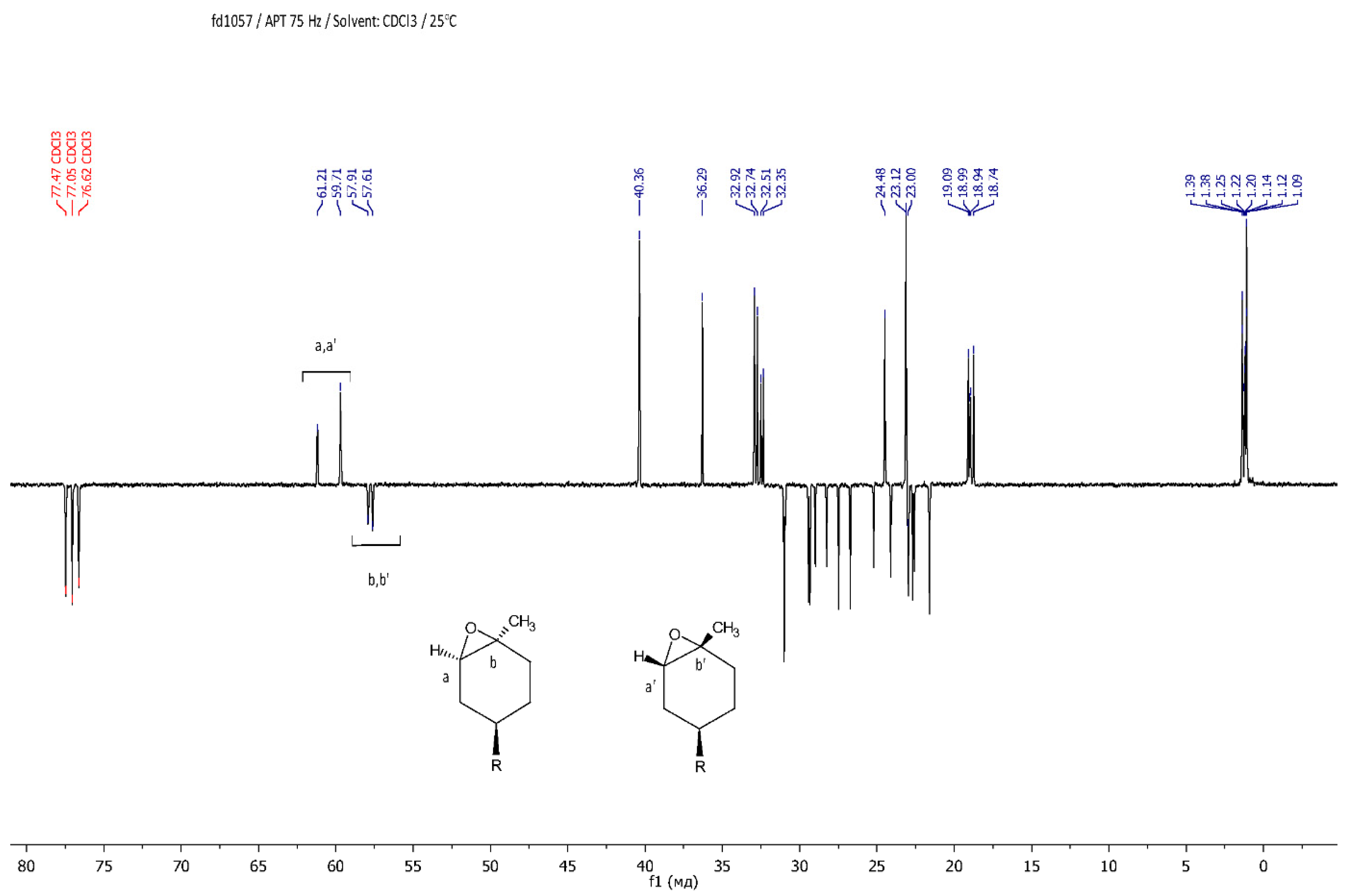
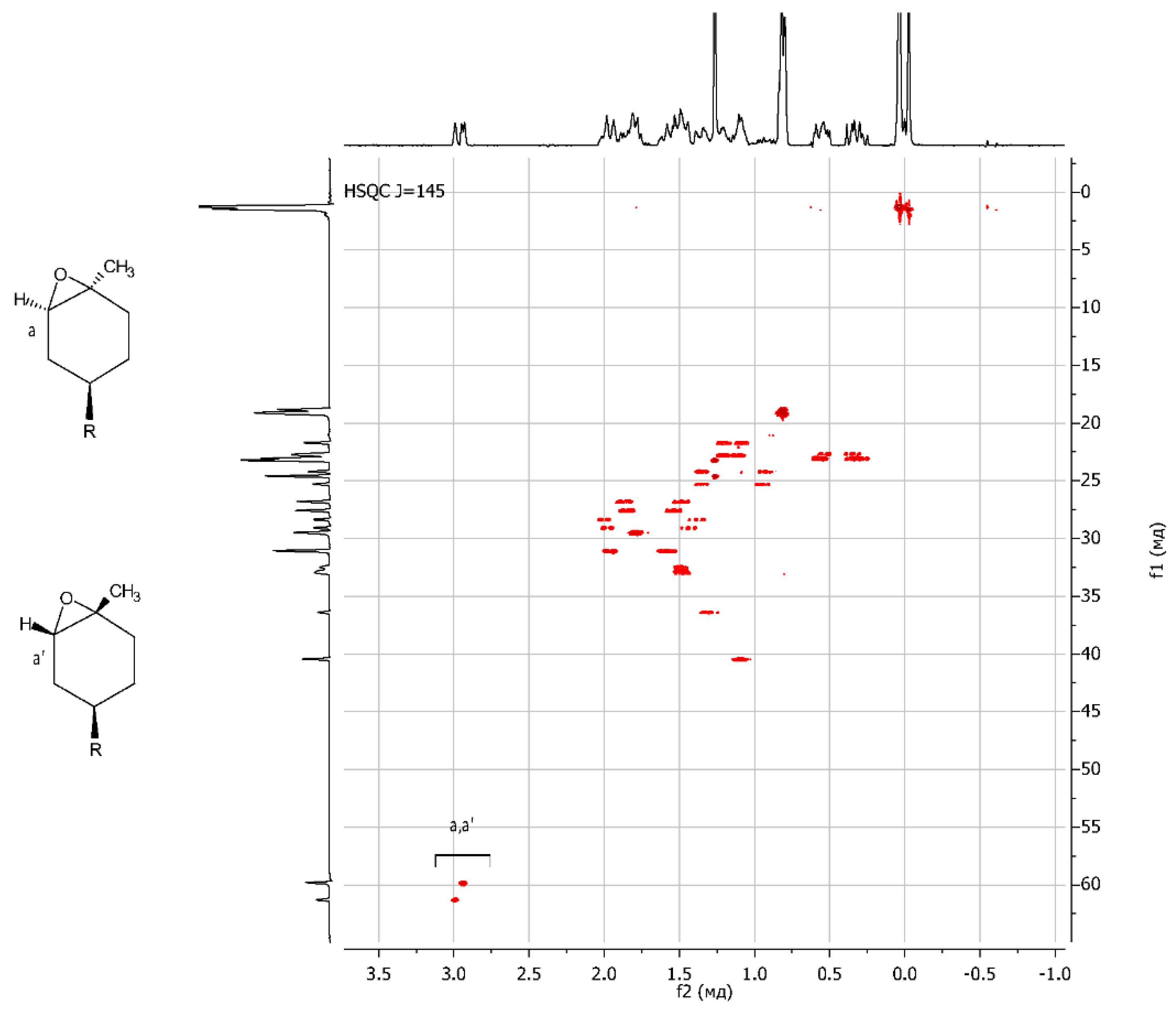
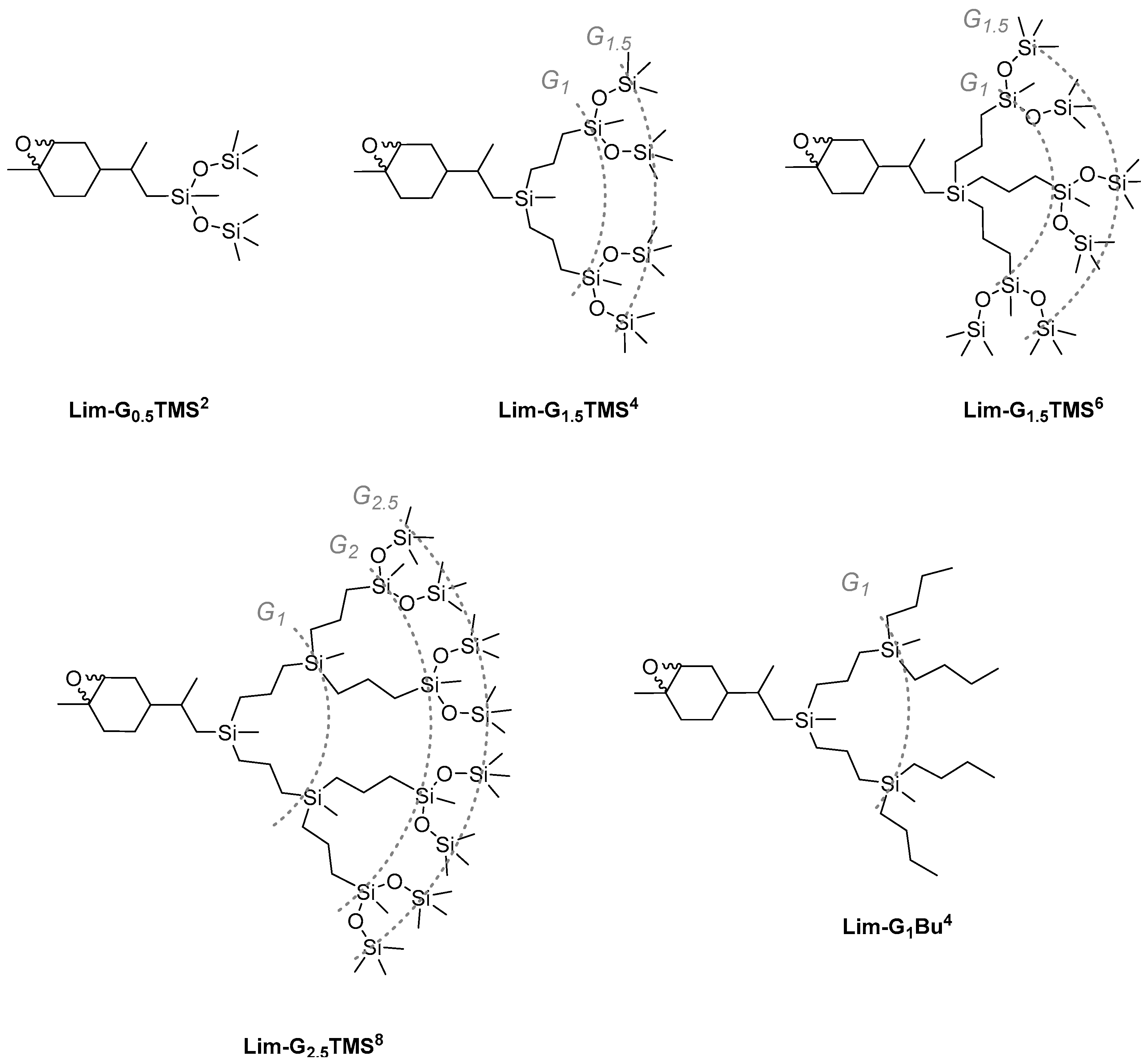
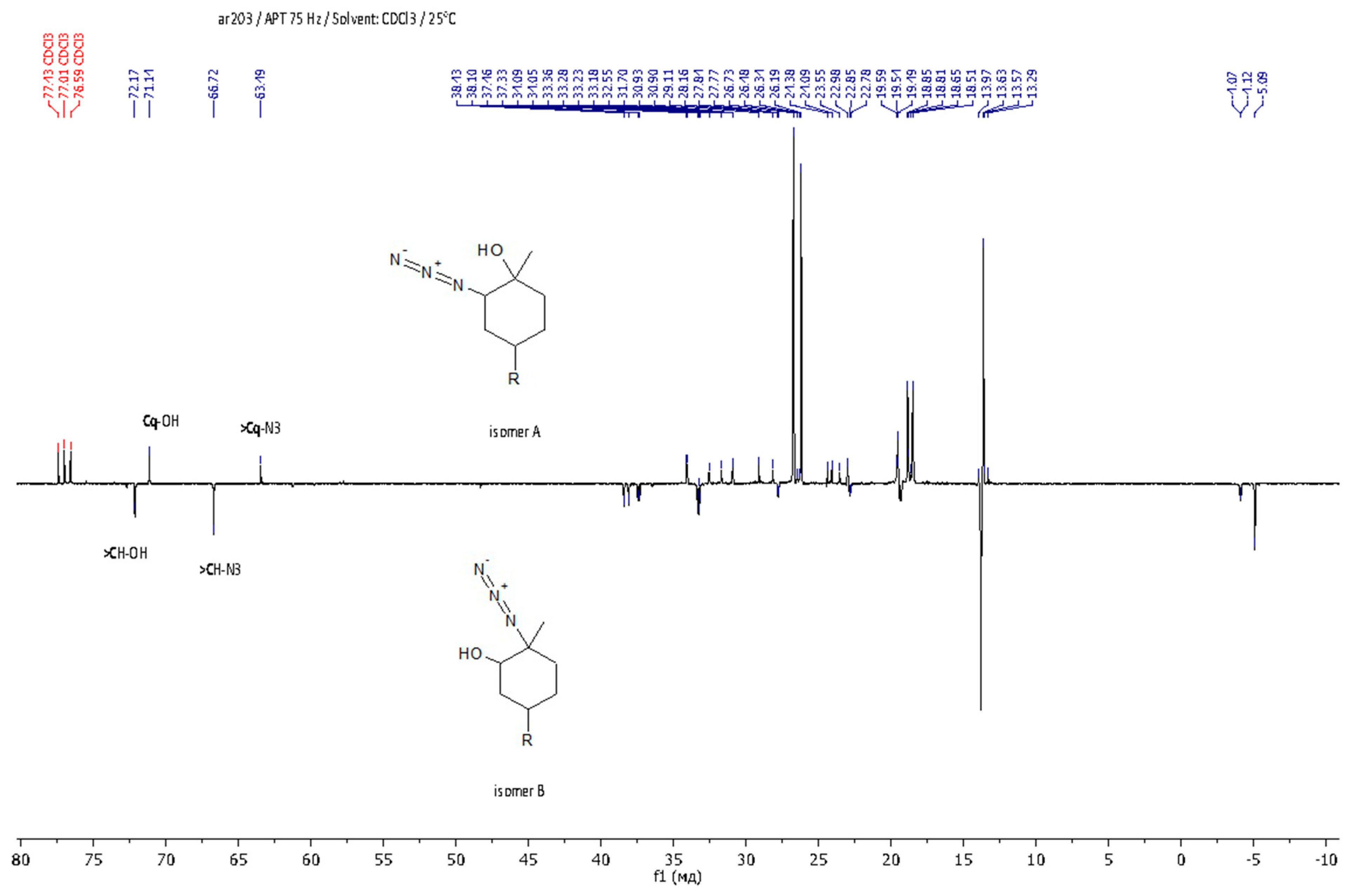
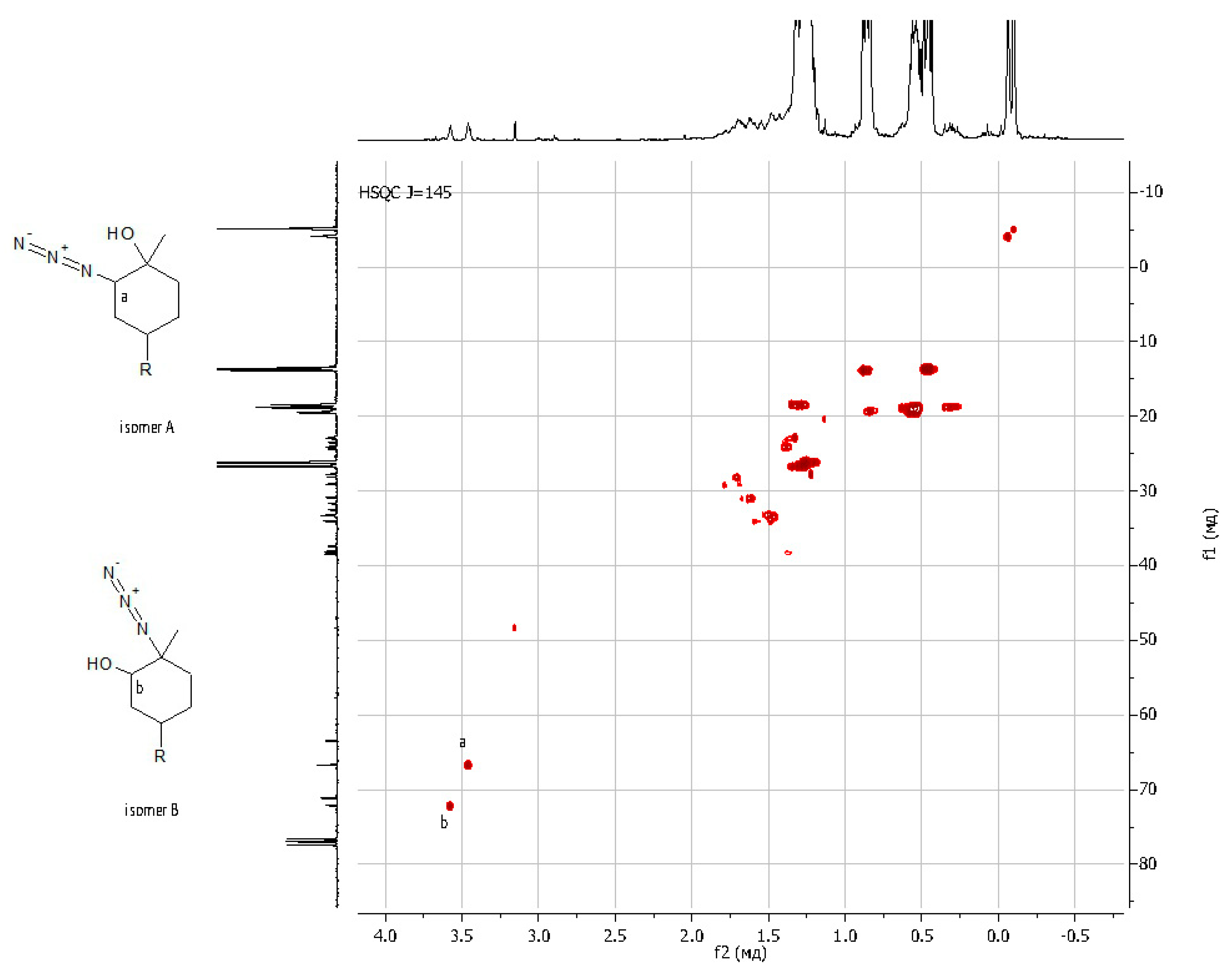



Disclaimer/Publisher’s Note: The statements, opinions and data contained in all publications are solely those of the individual author(s) and contributor(s) and not of MDPI and/or the editor(s). MDPI and/or the editor(s) disclaim responsibility for any injury to people or property resulting from any ideas, methods, instructions or products referred to in the content. |
© 2023 by the authors. Licensee MDPI, Basel, Switzerland. This article is an open access article distributed under the terms and conditions of the Creative Commons Attribution (CC BY) license (https://creativecommons.org/licenses/by/4.0/).
Share and Cite
Ryzhkov, A.I.; Drozdov, F.V.; Cherkaev, G.V.; Muzafarov, A.M. Approaches to the Functionalization of Organosilicon Dendrones Based on Limonene. Appl. Sci. 2023, 13, 2121. https://doi.org/10.3390/app13042121
Ryzhkov AI, Drozdov FV, Cherkaev GV, Muzafarov AM. Approaches to the Functionalization of Organosilicon Dendrones Based on Limonene. Applied Sciences. 2023; 13(4):2121. https://doi.org/10.3390/app13042121
Chicago/Turabian StyleRyzhkov, Aleksei I., Fedor V. Drozdov, Georgij V. Cherkaev, and Aziz M. Muzafarov. 2023. "Approaches to the Functionalization of Organosilicon Dendrones Based on Limonene" Applied Sciences 13, no. 4: 2121. https://doi.org/10.3390/app13042121
APA StyleRyzhkov, A. I., Drozdov, F. V., Cherkaev, G. V., & Muzafarov, A. M. (2023). Approaches to the Functionalization of Organosilicon Dendrones Based on Limonene. Applied Sciences, 13(4), 2121. https://doi.org/10.3390/app13042121





